10 Social Listening Tools and Who They’re Best for
By BrandwatchJul 14
Join us and boost your social media potential with our data-led event
Published September 28th 2017
Sitting somewhere between a research tool and a bit of fun, Twitter polls have been used extensively since their introduction two years ago. Want to start using them? Then read on.
Twitter polls are a Twitter feature which allows you to ask a question that other users can vote on within a tweet. You can have up to four answers and run the poll for as long as a week. Twitter tallies all the votes in the background and shows live results. Once finished, the tweet displays the final result.
So the concept is pretty straightforward. With such an open-ended feature, it’s no surprise it’s been used in hundreds of ways from the serious to the ridiculous.
This guide will outline how to create them, how they work, tips on creating good ones, and some interesting examples from others. We hope it helps.
First, let’s go into more detail on the functionality of the polls from a user perspective. This will get you ready for creating your first one.
Polls act just like any other tweet. They can be commented on, retweeted, liked, and shared just like everything else posted on the site. It simply contains the functionality of a poll. Here’s how they look in someone’s feed:
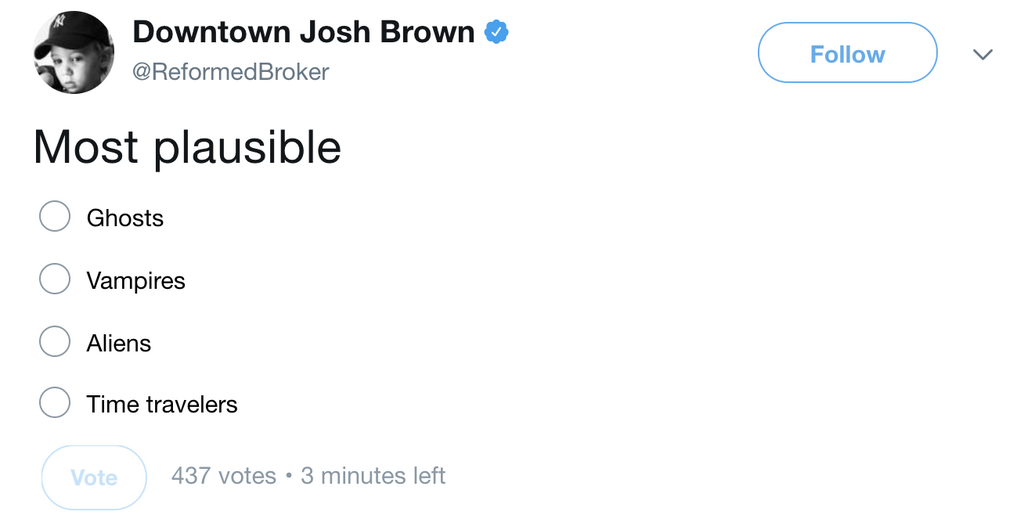
You have your question where the usual text of a tweet would go, followed by the options you can pick. At the bottom you can also see how many other people have voted along with how long the poll has left. Nice and easy.
Once you actually vote on a poll, it looks like this:
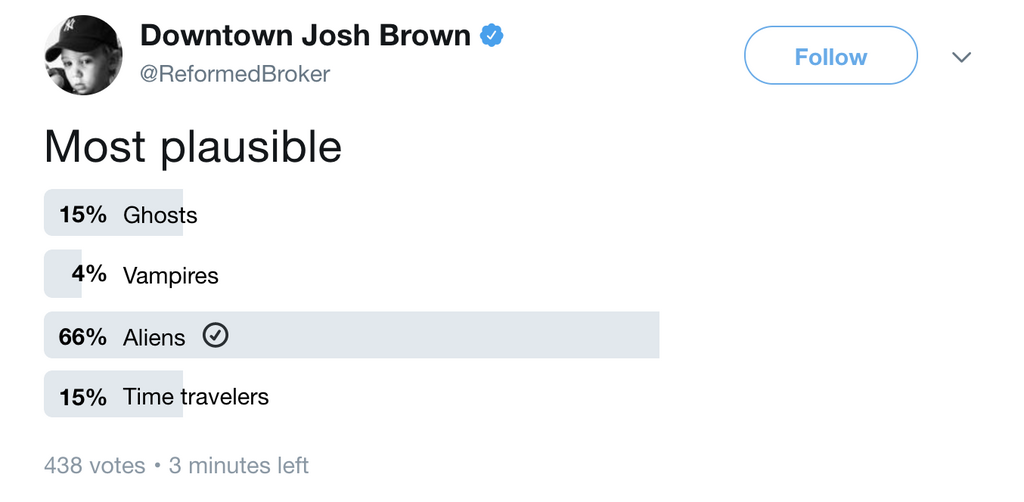
After you vote you get to see the results so far, with each answer’s percentage share displayed. They also add a little tick next to your answer. The number of votes so far and time left until the poll closes.
And, finally, once it’s all over, it looks like this:
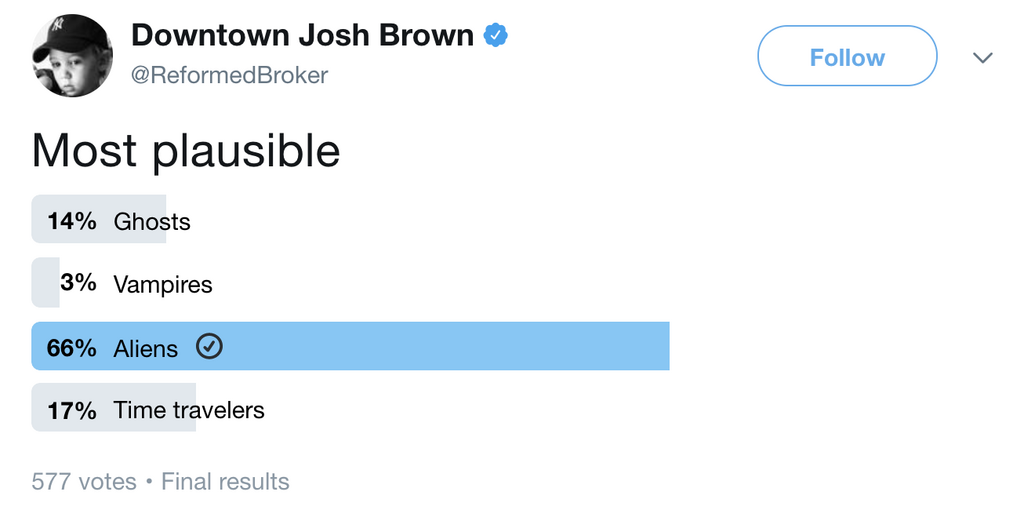
Another important point to make is that all votes are kept private. Neither other users or the creator of the polls can see who voted or which answer they chose. There’s no option to change this.
While in some cases this might mean a frustrating lack of data, it’s a good choice from Twitter. The votes you receive are more likely to be truthful as no one has to explain their choices, while it makes it hard to influence others to vote a certain way.
No, not really. They are good for a number of things, but not for any serious research. You also shouldn’t use them as the sole guide for any strategy either.
In other words, you won’t be able to run a Twitter poll and claim much statistical significance from them. For a start, you can’t see who voted so you can’t gain any demographic insight.
Meanwhile, you’re already starting with your own audience, which is only reflective of themselves and no larger group or demographic. If you’re a technology company, your audience might have an overrepresentation of techies, for example. On top of that you could want answers from Americans, but there’s nothing to stop Germans voting if they like.
And they’re easy to manipulate as well. There’s plenty of other issues at hand, but what we’re saying is that using Twitter poll results in any kind of serious study is not a good idea. You’ll need to carry out something far more stringent.
Luckily this is a pretty straightforward process. Head to Twitter as usual and go to create a tweet. You’ll notice a graph image underneath the text box. Click that to get started.

That will bring up the following. It’s then just a matter of filling everything in.
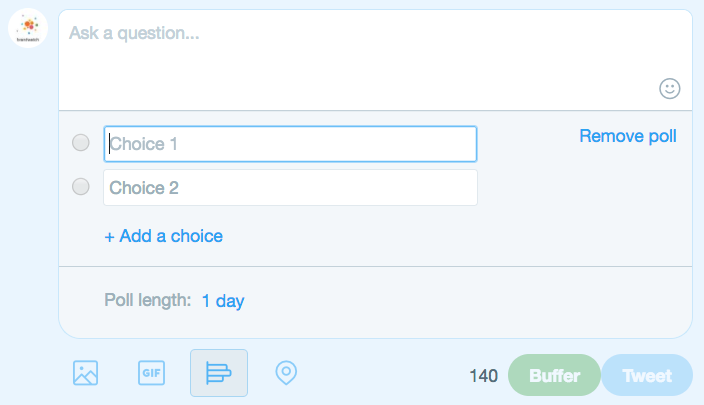
As previously mentioned, you can add up to four answers to your question. You then choose the length of time it will run for. The minimum is five minutes, with a maximum of a week.
And that’s all there is to it. Just click ‘Tweet’ and off it goes. Your followers, and whoever else sees it, can then vote for whichever answer they prefer.
Are Twitter polls essential for a good social strategy? Not especially. They’re just a fun and interesting way to change things up a bit. With the right poll you can drive a lot of engagement, gain some followers, and entertain your existing ones.
Just like in the NHS example we’ll discuss below, you can use them to get a feel of what your followers enjoy. Letting them choose discussion topics, for example, is an excellent way to pick what to talk about and to get people listening.
Polls can spark interesting and entertaining discussions as well, as all the voters debate the answers underneath the tweet. Then you’ve got a perfect chance to interact with your followers directly.
In the end, they’re free to create and don’t take much time. So why not?
To get you started, here’s some pointers on creating your polls. After a few attempts you’ll get a good handle on what your audience enjoys and reacts to so, as always, analyse, test, and refine as you go.
While Twitter polls can be about anything, it’s worth considering how relevant you want to keep the topic to you and your brand. Going way off might mean your audience won’t really engage as they’re not interested, but on the other hand something more general might have a wider appeal.
It’s a balancing act, really. For example, one of our products, Brandwatch Analytics, is a social listening tool. Does that mean any poll we do should specifically be about social listening and nothing else? Obviously not. It’s a bit too relevant and not broad enough to make it the subject of every poll we do.
We have two options here that keep the polls relevant, but don’t restrict them.
First, we can pull out data using our tool and then create polls around our findings. For example, we could find an interesting data point – like when the most hungover day of the year is – and make a quick quiz out of it.
That way we create something that has a wide interest, but is tied back to our product.
Another option is to look a bit wider. Yes, we offer social listening, but it’s a way of looking at and analyzing social media as a whole. That means we could use the topic of social media, or we could look at marketing technology, or maybe go wider and look at technology in general.
Don’t be worried about stretching out a bit, just keep your target audience in mind when doing so. If they can relate the topic back to you, then go for it.
What better way is there to get people talking and engaging than riling them up? Jumping on the latest hot topic can be a good way to get some attention for your poll, but often these subjects can be controversial.
Let’s say you own a sportswear company in the US. A huge topic at the moment is about NFL players kneeling during the national anthem. So you might think a poll asking for opinions on that might be a good idea.
Chances are you’ll get a fair bit of engagement, but it’s also easy to see a number of your followers having a very heated argument below your tweet. It’s not really the kind of engagement you want and it creates hostility between your followers.
Some brands are happy to get these kinds of conversations going, and that’s fine. But most others don’t, so always stop to think about the kind of debate you might cause. Debating the best sandwich filling is great. A visceral argument about patriotism and whether people should be fired? Not so much.
The timeline is a fast and furious place. If you want to maximise the reach of your poll beyond retweeting it yourself, you could pin the post to the top of your profile page. This way anyone who comes to your profile will see it.
You can pin polls just like any other tweet. Just head to your tweet and click on the downwards arrow in the top right corner. A drop menu will appear and all you need to do is click on ‘Pin to your profile page’.
Just don’t forget it’s there. That’s prime profile space! Keep your pinned posts changed up regularly.
Now you’ve got creating Twitter polls down, it’s time to think of some ideas. We’ve put together a list of some concepts to get you inspired. It’s not exhaustive, but it’ll get you off to a good start.
Twitter polls can give you a quick snapshot view on your own offering, be it software or food. As a warning, don’t use this as your only research method! It should supplement proper research and interviews, or help point you in the direction of any problems you hadn’t already picked up.
It’s a great way to engage with your customers too. Ask them to supply comments with their vote to get some extra insight. Even better if you can come back to them after implementing their suggestion.
Our example below is from Benjamin Rivers, an indie game developer, asking for opinions on audio types in games. Nice use of emojis too.
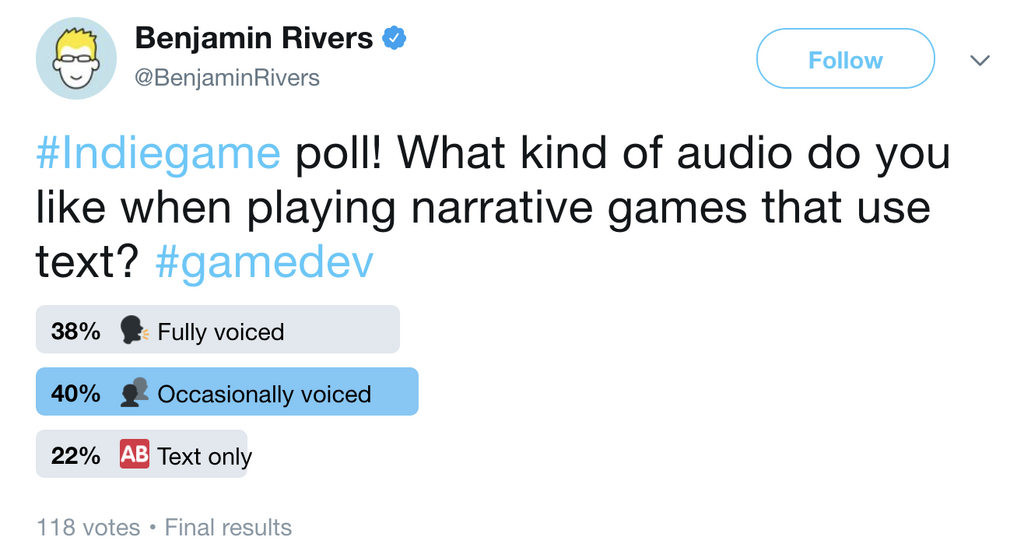
By far the most difficult and time-consuming to plan, they can be a huge driver of engagement and brand awareness.
The idea itself is simple, you use Twitter polls to match things up against each other. Users vote and the winner goes through to the next round. You keep this up until there’s only one thing left which is declared the champion.
There have been a few great examples of this, which even picked them up some press coverage.
Pointless host, Richard Osman, has run a few ‘World Cups’ on biscuits and chocolate. He combined it with supporting a charity and people really got into it. Even the BBC picked it up.
But a personal favourite was Thom Phipps’ ‘The Simpsons World Cup’. This pitched 32 of the series’ best episodes against each other. The whole competition spanned two weeks with a total of 31 separate polls run to find the winner.
It took a lot of Twitter threading and organisation, but it really paid off. The NME, JOE, and others wrote articles about it, while the final poll generated over 300 retweets. Not bad.
THE FINALE #SIMPSONSWORLDCUP
PLEASE RETWEET— thom (@thwphipps) August 3, 2017
Why not use Twitter polls to guide how you interact with your users? They can be very handy to get an idea of what things people are really interested in.
A great use is to help plan topics for discussions or blog posts. Simply chuck out a few suggestions and then use the most popular one. That gives you a bit of confidence that people will enjoy what you produce. It’ll also increase engagement from those who voted.
The usual caveat applies though. Don’t base your entire strategy on Twitter polls. Use it sparingly and for small projects for the best effect. The NHS poll below, where a discussion topic is decided, is a perfect example.
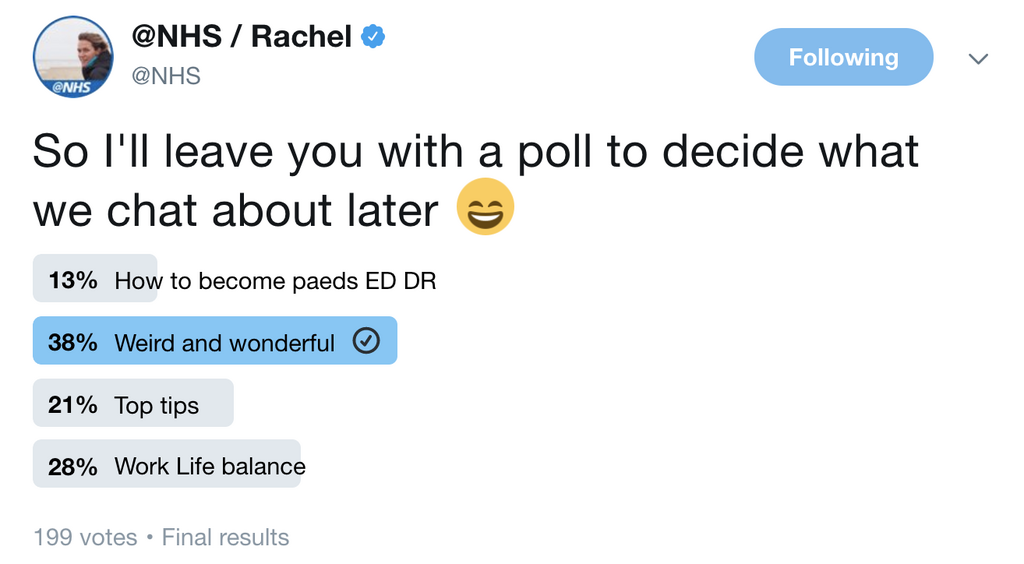
This could be advice for yourself or your audience. Polls can get you a quick response on the best way to do something. This could be asking about certain tools to people’s approach to making eggs.
It’s another approach that can get people debating as well. If people start doing so (in a civil way), try to encourage the conversation and get as much out of it as possible. If there’s enough content you could consider writing a blog post on the subject with the input of your audience.
The example below is a nice one. Sylvain Deville is a scientist and used his Twitter poll to see if other scientists sent their papers around before submitting them for review.
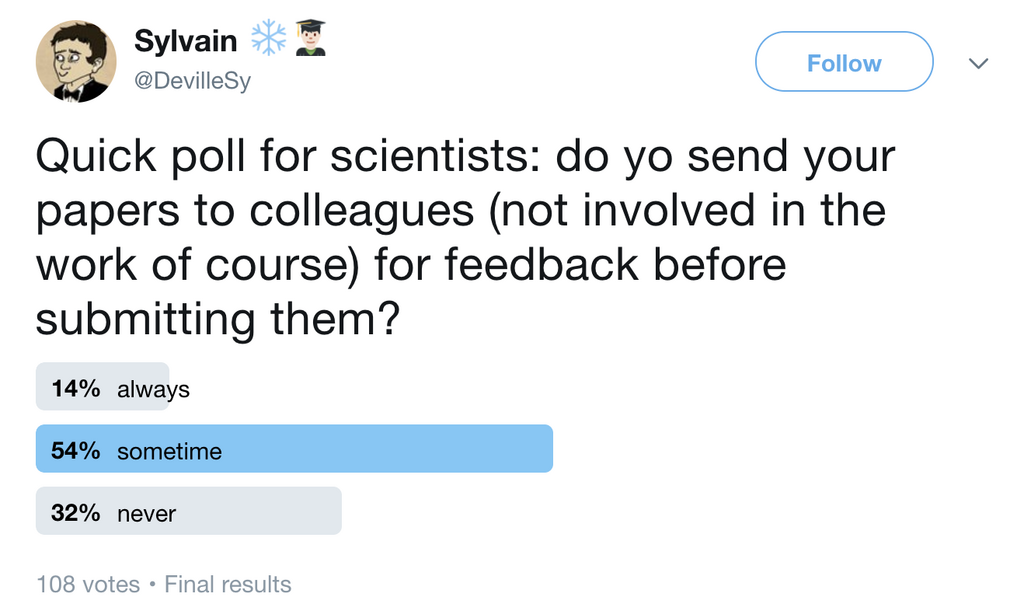
*honks clown nose*
Comedians have been using Twitter’s format for jokes pretty much since it launched. Twitter polls are no exception. They can be set up pretty well for jokes, so don’t be scared to use polls for not-so-serious reasons.
Always keep in mind the controversy and relevancy aspects we talked about earlier. Don’t try to be edgy, while avoid going too far off topic. That can be hard, particularly if your industry might seem a bit dull, but there’s always humour to find. If you’re niche, go niche. Your followers might appreciate it.
The below is from comedian, Samantha Ruddy. It shows just how simple you can go to get a good laugh.
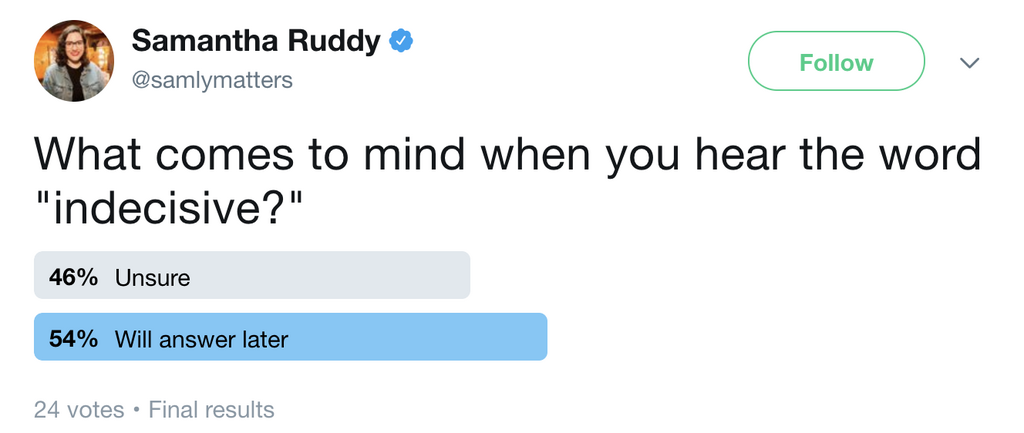
Polls don’t have to be a one off. You can make them a regular feature of your Twitter account. Obviously don’t go overboard, but depending on the engagement you get, you could be looking at one a day. We’d suggest starting with one a week and going from there though.
What you do will be down to you and your audience. You could do a regular version of any of the types in the list. You could just ask for the general opinions of your followers. If you’re in the music industry, why not do an album of the week poll?
Geek & Sundry do a weekly #GatherYourParty poll where they let their fans influence the topic of their Twitch shows.
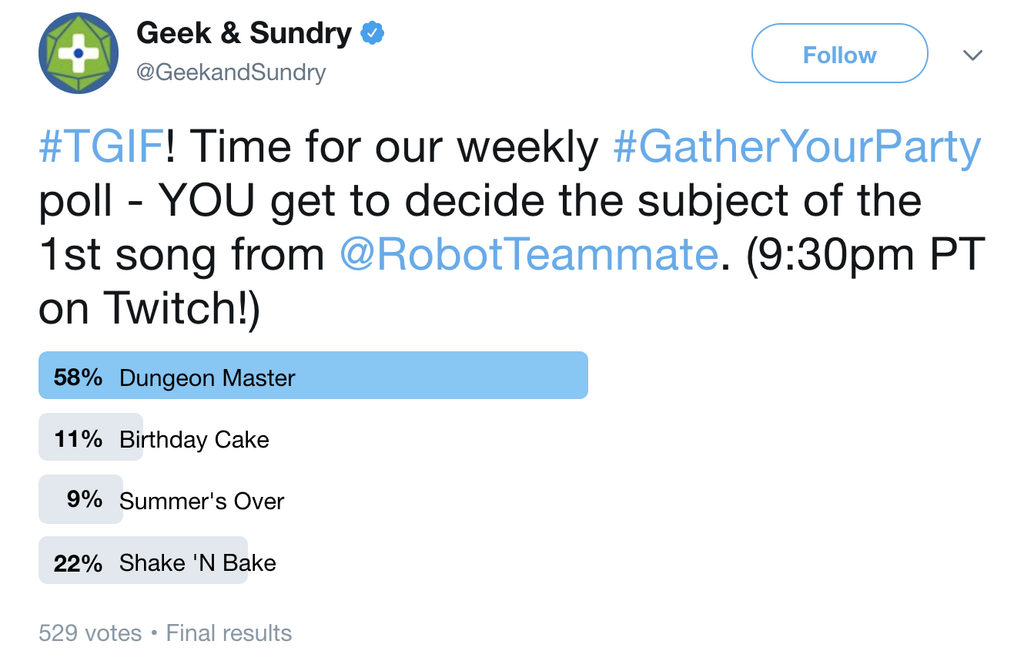
Now you’re all set to start creating your own Twitter polls. Don’t be afraid to experiment where you can. Be sure to let us know if you create any polls after reading our guide as well.
Offering up analysis and data on everything from the events of the day to the latest consumer trends. Subscribe to keep your finger on the world’s pulse.
Existing customer?Log in to access your existing Falcon products and data via the login menu on the top right of the page.New customer?You'll find the former Falcon products under 'Social Media Management' if you go to 'Our Suite' in the navigation.
Brandwatch acquired Paladin in March 2022. It's now called Influence, which is part of Brandwatch's Social Media Management solution.Want to access your Paladin account?Use the login menu at the top right corner.